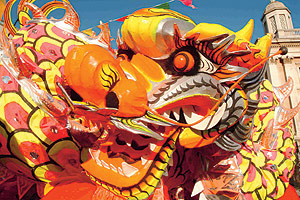Also known as «Middle Country«. These were the names given by the Chinese to their homeland for millennia, as they considered it the center of the world. This is an evident geographical mistake. However, taking into account China’s role in cultural (and economic) terms vis-à-vis the rest of the world, the idea of «being in the middle» isn’t so mistaken after all.
This Civilization’s history beings at the end of the third millennium B.C., when nomadic peoples from the Gobi desert settled along the Hoang-ho (Yellow River) basin. These gave birth to the first dynasties, which in turn provided the foundation for one of the most enduring empires in human history. China, the official name of which is «Popular Republic of China» (ever since 1949), stretches over a vast area of Central and Southeastern Asia. It is the most inhabited nation on the planet, with 1,306,313,812 (2005), nearly 25% of total global population. Its surface is of 9.596,960km2, the third largest country after the Russian Federation and Canada.
China borders with Mongolia and the Russian Federation to the North; Kazakhstan, Kyrgyzstan, Tajikistan, Afghanistan and Pakistan to the West; North Korea, the Yellow Sea, the East China Sea and the South China Sea to the East; and India, Bhutan, Myanmar, Laos and Vietnam to the South.
The Capital is Beijing (Former Peking). Administratively, the country is divided into 23 provinces (including Taiwan), 5 autonomous regions (Inner Mongolia and Tibet among others) and 4 municipalities (among which are Beijing and Shanghai). Furthermore, Hong Kong and Macao are considered special administrative regions.
China is a Communist State. The President (currently Hu Jintao) is the Head of State. Under the President’s authority is the State Council, led by the Premier -nowadays Wen Jiabao. The President, Hu Jintao and the Vice President, Zeng Qinghong were elected by the National Assembly.
Land of Diversity
Given its vastness, China contains a great variety of landscapes and climatic zones. Alluvial plains with a high concentration of population run along the coast of the Yellow and East China Seas, in the West of the country. The South China Sea littoral zone is mountainous. Small mountain ranges and abundant rain are found in the southern part of the country. China’s central area is where the deltas of the two mayor rivers, the Yellow River and the Yangtze, are located. The West is characterized by high mountain ranges, as are the Himalayas and also by high, dry plateaus as the TaklaMakan and Gobi deserts.
China also possesses an ethnically diverse population. Although 90% belong to the Han group (Chinese), there are another 55 ethnic groups, among others: Mongols, Hui people, Tibetans, Uyghurs, etc. Several religions also coexist in the country. Some are: Confucianism, Taoism, Buddhism, Islam and Catholicism.
The Dragon Awakens
Chinese economy could be defined as being resistant as silk and yet flexible as bamboo. In the last few decades, the «Asian Dragon» carried out a process of economic opening, intensively promoting the creation of private companies and attracting foreign investment. The state, however, kept its control and planning role.
This, combined with skillful diplomatic maneuvers has led to China’s recovery of its age-old supremacy in Asia.
According to estimations by the World Bank, the country will be the world’s second economy (after U.S.A.) within the next 5 years and the first economy by the year 2050.
China’s astounding economic growth has not only had an impact on its own territory and on the Asian continent, but also on the whole world. This as China, apart from becoming a «giant» exporter, has also become a great consumer. For example, it currently buys around 40% of the world’s cement. Moreover, the huge volumes it moves in foreign trade make other countries dependant on China for their growth, as in the case of Germany, where trade with China accounts for 20% of total growth.
Some analysts, however, fear that the fast Chinese expansion, which currently reaches 9%, could lead her to a collapse (rise in prices, increase in loans, etc.) dragging the world economy with her.
Nowadays, China’s main exports are: machinery, textiles, footwear, toys, chemical and electronic products. Chinese import: «high tech» products, petrol, steel, copper, iron, cement, etc.








 Muere Evita
Muere Evita